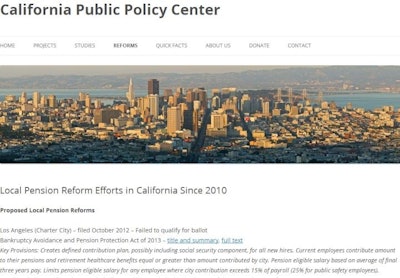 Beware of anti-pension propoganda from the California Public Policy Center.
Beware of anti-pension propoganda from the California Public Policy Center.
Here in California, they've have created a "think tank" to operate a series of websites that appear to be nominally independent. The group churns out "analysis" and opinion pieces to make it appear as if there is a groundswell of interest behind their unsubstantiated attacks.
The mother ship of this activity is the independent-sounding "California Public Policy Center" (CPPC). Among its active supporters are well-known pension opponents Jon Coupal, Jack Dean, and Steve Greenhut, the former Orange County Register columnist who also writes for the Pacific Research Institute.
Don't be fooled by the slick websites and legitimate-sounding names. The CPPC has its own website called Pension Tsunami and supports an elaborate string of websites—labeled with fancy names to fool reporters and the public. The beauty of these websites is that they allow their operators to hide in the shadows, with no single individual responsible for the misinformation they disseminate.
Consider the author of many of these reports on public pensions, Ed Ring. He doesn't outline his credentials anywhere. Try Googling the name Ed Ring—you will find his anti-pension pieces, but not his professional credentials. The most that can be determined is that he was once a "research fellow with the National Tax Limitation Foundation" and now he is the "research director" of the CPPC at the end of his rants against pensions. Nothing else.
Here's how the creative scheme works. Pension critics create some faux analysis of an issue, and then distribute it to a handful of columnists or reporters. They, in turn, regurgitate the talking points in several different publications. Then it moves up the ladder when some of their reliably anti-union editorial boards, such as the U-T San Diego or Orange County Register, cite the "Policy Center's analysis." If they're lucky (and they sometimes are), more mainstream papers or editorial boards will swallow the bait and parrot some of the CPPC's claims.
As a result of the misstatements in those editorials, people who know the facts write letters to the editor (that rarely get published) bemoaning the false reports. But in today's age, letters to the editor are passé, usually replaced by mean-spirited invectives in the "comment" portion of news stories on a newspaper's website.
These manufactured stories and editorials that sprout from these groups have legs, living on in internet searches. It's a new playbook for propaganda distribution from the anti-public pension crowd—one that everyone needs to be aware of and actively question.
Editor's Note: This blog post first appeared on the Los Angeles Police Protective League's website.














